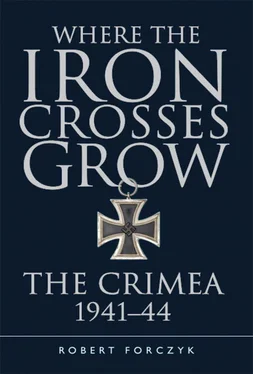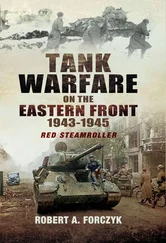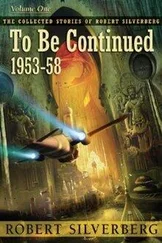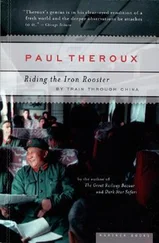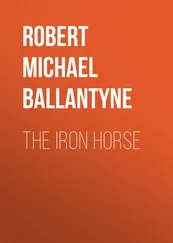On the same day as Schobert’s death, SS-Sturmbannführer Kurt Meyer’s Aufklärungs-Abteilung LSSAH from the Leibstandarte SS Adolf Hitler (LSSAH) division approached Perekop after a 35-mile dash from the Berislav bridgehead. Oberstleutnant Oskar von Boddien’s Aufklärungs-Abteilung 22 was close behind, and together these two reconnaissance units reached the village of Preobrazhenka, 5 miles north of the Tatar Wall, at around 0600hrs. Meyer had a mixed reconnaissance group of Kradschützen (motorcycle infantry), a few armored cars, and a Panzerjäger platoon with 3.7cm antitank guns, but no artillery or engineers. Upon entering the village, his lead company was fired upon by 76mm guns from the Soviet armored train Voykovets and engaged by small-arms fire from dug-in Soviet infantrymen. 2nd Battalion/361st Rifle Regiment from Danilin’s 156th Rifle Division was entrenched in a strongpoint in the nearby Chervonyi Chaban State Farm. In addition to this strongpoint, Meyer could see that the area further south around Perekop was heavily fortified with bunkers and barbed wire. He beat a hasty retreat under cover of smoke and reported back to LIV Armeekorps that, “coup against Perekop impossible.” [9] Paul Carell, Hitler Moves East 1941–1943 (Winnipeg: J.J. Fedorowicz Publishing, 1991), pp. 262–264.
CHAPTER 3
Across the Tatar Wall, September 1941
“…and I will show you where the Iron Crosses grow….”
Feldwebel Rolf Steiner,
The Cross of Iron (1977)
When Manstein arrived at Nikolayev on September 17 to take command of the 11. Armee (AOK 11), he found that the bulk of his forces were advancing toward Melitopol while Hansen’s LIV Armeekorps had moved its 46. and 73. Infanterie-Divisionen up near Perekop but had taken no action to reduce the Soviet defenses. XXX Armeekorps had sealed off the Chongar Peninsula and Arabat Spit with the LSSAH Division, but also had made no effort to penetrate into the Crimea. Schobert’s death had given Kuznetsov a vital breathing space in which to enhance his defenses. The difficulty of moving supplies across the Dnepr, with all bridges down, also made it difficult for the 11. Armee to mount a hasty assault at Perekop, since LIV Armeekorps was short of fuel and artillery ammunition.
Danilin’s 156th Rifle Division built three lines of defense across the Perekop Isthmus, with the main line of resistance centered upon the Tatar Wall. The outer line of defense consisted of two rifle battalions deployed in forward strongpoints, each supported by an artillery battalion. Colonel Vladimir P. Shurygin, the 51st Army’s senior engineer, used civilian labor to dig a 6ft-deep antitank ditch behind this outer covering force, and emplace four lines of tanglefoot-type barbed-wire obstacles. Shurygin’s engineers built concrete and timber/stone bunkers for 76mm cannon and 45mm antitank guns in the main line of resistance, as well as digging in several tanks. The Tatar Wall itself was fronted by the ancient moat, which was now 36ft deep and 104ft wide; the wall sat atop a 15ft-high earth berm. The area was completely open, without trees or vegetation, and the Soviets could observe every move that the Germans made. However, the most frightening aspect of the Perekop defenses for the Germans was the extensive use of antipersonnel mines; up to this point in the war the Wehrmacht had not yet had to penetrate a defense of this kind. Not only did Shurygin’s engineers emplace thousands of PMD wooden antipersonnel mines, but they buried 50kg aerial bombs and even large naval mines from the depots at Sevastopol. Another innovation was the use of buried flamethrowers with trip wires. Indeed, Kuznetsov got a bit carried away in sending materiel to reinforce the Perekop defenses, including some mines filled with mustard gas; when the Stavka learned of this, Kuznetsov was rebuked and told not to employ chemical weapons without permission. [1] General Staff Order No. 001980, 15 September 1941, TsAMO, F. 48, Op. 3408, D. 4, L. 214.
Luftwaffe aerial reconnaissance was able to detect much of the Soviet defensive preparations at Perekop, which were unsettling for Manstein. He hoped to avoid a costly frontal assault, and set the 11. Armee’s engineers to finding a method for bypassing the Perekop defenses, just like his Sichelschnitt plan had bypassed the French Maginot Line in 1940. Leutnant Nübling from Gebirgs-Pionier-Regiment 620 conducted an extensive reconnaissance and survey of the Sivash, hoping to find a route across as the Red Army had done in 1920. However, tidal conditions at this time were unsatisfactory; the water at the narrower western end of the Sivash was less than a yard deep, but the bottom was too soft and German scouts sank in to their hips. Manstein asked if assault boats from the 902 Sturmboote-Kommando could be used to cross the Sivash, but Leutnant Nübling found that the water conditions were unfavorable. [2] Ia, Anlagenteil 4 z. KTB 2, Möglichkeiten zum Angriff auf die Krim über den Ssiwasch , September 1 – October 31, 1941, 11. Armee, NAM (National Archives Microfilm), series T-314, Roll 1340.
Furthermore, Kuznetsov expected the Germans to try and cross the Sivash and directed Danilin to put two rifle battalions from his 530th Rifle Regiment on the Litovsky Peninsula where the Red Army had crossed in 1920. Nor did the route across the Chongar Peninsula look promising, since the Soviets had blown up the main railroad bridge and emplaced obstacles in the water.

1. September 24: LIV Armeekorps captures the Chervonyi Chaban strongpoint and begins pushing in Soviet 51st Army covering forces.
2. September 25: A Soviet armored spoiling attack only delays Germans from rolling up outer defenses.
3. September 26: 46. and 73. Infanterie-Divisionen breach the Tatar Wall defences, reaching the outskirts of Armyansk, but are halted by Soviet counterattacks.
4. 22. Infanterie-Division conducts a demonstration along the Sivash to force the Soviets to divert forces to defend the Litovsky Peninsula.
5. September 27–28: Group Batov launches counterattacks at Armyansk, temporarily halting the German advance. Troops from the 50. Infanterie-Division arrive, swinging the battle in favor of the Germans.
6. September 28: 51st Army retreats to the Ishun position.
7. October 18: LIV Armeekorps begins assault upon the Ishun position. 22. Infanterie-Division pushes back the Soviet right flank on the Sivash but is repulsed at the Tumulus Assis burial mound.
8. October 19: 73. Infanterie-Division achieves a major breakthrough, captures Ishun, and reaches the Chatyrik River.
9. October 22: Soviet Coastal Army launches a major counterattack at Ishun, which is repulsed.
10. October 21-26: Both sides feed more forces into the fighting south and east of Ishun. The other two German divisions gradually mop up the lake areas and begin pushing toward the southeast. After days of heavy fighting, the 51st Army begins to retreat.
Thus, Manstein was forced to conduct a frontal attack at Perekop. He knew that in order to break a fortified line, particularly in a place where any form of maneuver or surprise was impossible, it would be imperative to add every combat multiplier possible to give the assault a reasonable chance for success. His only armor support came from the assault guns from Sturmgeschütz-Abteilung 190. [3] Franz Kurowski, Sturmgeschütz vor! Assault Guns to the Front! (Winnipeg: J. J. Fedorowicz Publishing, 1999), p. 43.
Since Barbarossa had envisioned maneuver warfare, not positional battles or sieges, the 11. Armee had limited artillery and engineer assets, so Manstein would have to rob from Peter to pay Paul. He decided to accept the risk with XXX Armeekorps, involved in the pursuit to Melitopol, and transfer as much of its combat resources as possible to Hansen. Manstein provided Hansen with four additional heavy-artillery battalions (schwere Artillerie-Abteilung 737 with three Czech-made 14.9cm howitzers; schwere Artillerie-Abteilung 641 with four Czech-made 30.5cm mortars; I./AR 814 with two Czech-made 24cm howitzers, four 10cm s.K 18, and three 15cm s.FH 18; and the Romanian 54th Heavy Artillery Battalion with 12 Skoda 15cm howitzers), plus a Nebelwerfer battery. He stripped XXX Armeekorps of its corps-level artillery, transferring II./AR54 and IV./AR207 to Hansen. When added to his two divisional artillery regiments, Hansen’s artillery park totaled about 152 pieces. When Manstein first took command, LIV Armeekorps was short of artillery ammunition, but by September 23 Hansen had received enough medium-caliber ammunition to mount a attack. However, the heavy-artillery ammunition was very limited, with only 100 rounds of 24cm and 133 of 30.5cm for each assault division. [4] Ic, Tätigkeitsbericht, July 17 – November 16, 1941, 73. Infanterie-Division, NAM (National Archives Microfilm), series T-315, Roll 1065.
Hansen also received 2,575 replacements just five days before the attack at Perekop, bringing his two infantry divisions back up to strength. The offensive was set for September 24, and Manstein kept part of the LSSAH Division in reserve to exploit the expected breakthrough.
Читать дальше
